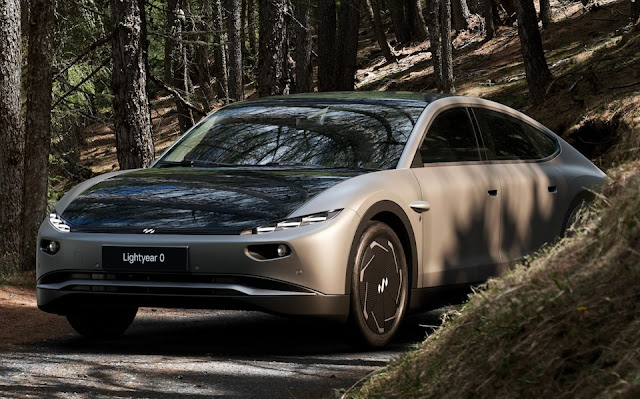The Lightyear 0 model
A Dutch company is starting deliveries of the world’s first commercial solar car this year, potentially ramping up competition in the auto industry’s race to net zero.
Lightyear, founded in 2016, is producing almost 1,000 of the primarily battery-powered models, fitted with curved solar panels across the roof and bonnet. The company claims power from the sun can contribute up to 44 miles to the vehicle’s 388-mile range per day.
Available to pre-order at a cost of $263,000 (£216,000), Lightyear 0 will allow short drives to be purely solar-powered during the sunniest months of the year.
While not new, it has been pegged as a potential solution to the lack of available chargers holding back the electric vehicle (EV) revolution. There are questions, however, over how efficient the concept is - particularly in an often cloudy Britain.
In the Netherlands, for instance, just two months of the year will provide enough sun to reach the 44-mile capacity, while in Spain or Portugal that sun-powered peak can be reached during seven months.
Lightyear says it will sell cars in the UK and US by 2025, most likely in Edinburgh. There, solar panels can power the car for 8.8 miles per day.
It is one in a number of companies in recent months to get some of its power from solar panels and to start or be close to production.
Earlier this year, Mercedes-Benz dipped a toe into the market with its Vision EQXX electric car, which can drive 1,000km on a single charge. Roof solar panels added 25km of range during an 11-and-a-half hour test drive through the Alps in April.
Earlier this month, meanwhile, a team of Belgian students from the Catholic University of Leuven drove 1,051km in a solar vehicle over 12 hours, claiming a world record. But with room for just the driver, it is unlikely to be on sale soon.
Solar panels haven’t been a prominent feature on cars because of the trickle of charge they supply from a limited surface area, according to automotive expert Jim Saker, emeritus Professor at Loughborough University and president of the Institute of the Motor Industry.
Shade from tree-lined roads or tunnels in urban areas is a challenge that stationary solar farms do not face.
In 2017, Elon Musk said that while he is a fan of solar power, Tesla has shunned the technology as “the least efficient place to put solar is on the car”. The Telegraph - link - Howard Mustoe - link - more like this (electric cars) - link - more like this (Netherlands) - link
Available to pre-order at a cost of $263,000 (£216,000), Lightyear 0 will allow short drives to be purely solar-powered during the sunniest months of the year.
While not new, it has been pegged as a potential solution to the lack of available chargers holding back the electric vehicle (EV) revolution. There are questions, however, over how efficient the concept is - particularly in an often cloudy Britain.
In the Netherlands, for instance, just two months of the year will provide enough sun to reach the 44-mile capacity, while in Spain or Portugal that sun-powered peak can be reached during seven months.
Lightyear says it will sell cars in the UK and US by 2025, most likely in Edinburgh. There, solar panels can power the car for 8.8 miles per day.
It is one in a number of companies in recent months to get some of its power from solar panels and to start or be close to production.
Earlier this year, Mercedes-Benz dipped a toe into the market with its Vision EQXX electric car, which can drive 1,000km on a single charge. Roof solar panels added 25km of range during an 11-and-a-half hour test drive through the Alps in April.
Earlier this month, meanwhile, a team of Belgian students from the Catholic University of Leuven drove 1,051km in a solar vehicle over 12 hours, claiming a world record. But with room for just the driver, it is unlikely to be on sale soon.
Solar panels haven’t been a prominent feature on cars because of the trickle of charge they supply from a limited surface area, according to automotive expert Jim Saker, emeritus Professor at Loughborough University and president of the Institute of the Motor Industry.
Shade from tree-lined roads or tunnels in urban areas is a challenge that stationary solar farms do not face.
In 2017, Elon Musk said that while he is a fan of solar power, Tesla has shunned the technology as “the least efficient place to put solar is on the car”. The Telegraph - link - Howard Mustoe - link - more like this (electric cars) - link - more like this (Netherlands) - link

No comments:
Post a Comment